Download the notebook here!
Interactive online version:
Causal graphs
Introduction
Graph notation less general than potential outcome framework, but
thinking about causal systems
uncover identification strategies
It is useful to separate the inferential problem into statistical and identification components. Studies of identification seek to characterize the conclusions that could be drawn if one could use the sampling process to obtain an unlimited number of observations. (Manski, 1995)
The two most crucial ingredients for an identification analysis are:
The set of assumptions about causal relationships that the analysis is willing to assert based on theory and past research, including assumptions about relationships between variables that have not been observed but that are related both to the cause and outcome of interest.
The pattern of information one can assume would be contained in the joint distribution of the variables (associations) in the observed dataset if all members of the population had been included in the sample that generated the dataset.
\(\rightarrow\) causal graphs offer an effective and efficient representation for both
Basic elements of causal graphs
nodes
edges
directed paths
parent and child
descendant
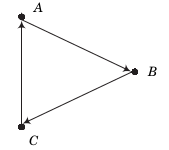
Two representations of the joint dependence of \(A\) and \(B\) on an unobserved common cause.

Let’s look at some basic patterns that will turn out to appear frequently.
chain of mediation
fork of mutual causation
inverted fork of mutual dependence
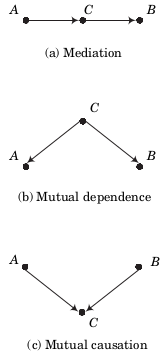
What about the unconditional and conditional association of \(A\) and \(B\) in each of these cases?
While there is unconditional dependence between them in the first two cases, there is not in the third.
The collider variable \(C\) in the third setting does not generate an unconditional association between \(A\) and \(B\). However, as we will revisit in more detail later, it can create a conditional association that needs to be handled with care.
Conditioning and confounding

The causal effects \(C \rightarrow D\) and \(C \rightarrow Y\) render the total association between \(D\) and \(Y\) unequal to the causal effect \(D \rightarrow Y\).
\(C\) is a confounding variable that affects both the dependent and independent variable.
Conditioning is a modelig strategy that allows to determine causal effects in the presence of observed confounders.
\(\rightarrow\) What happens if \(C\) is unobserved?
How about an example from educational choice where we have observed and unobserved confounders?
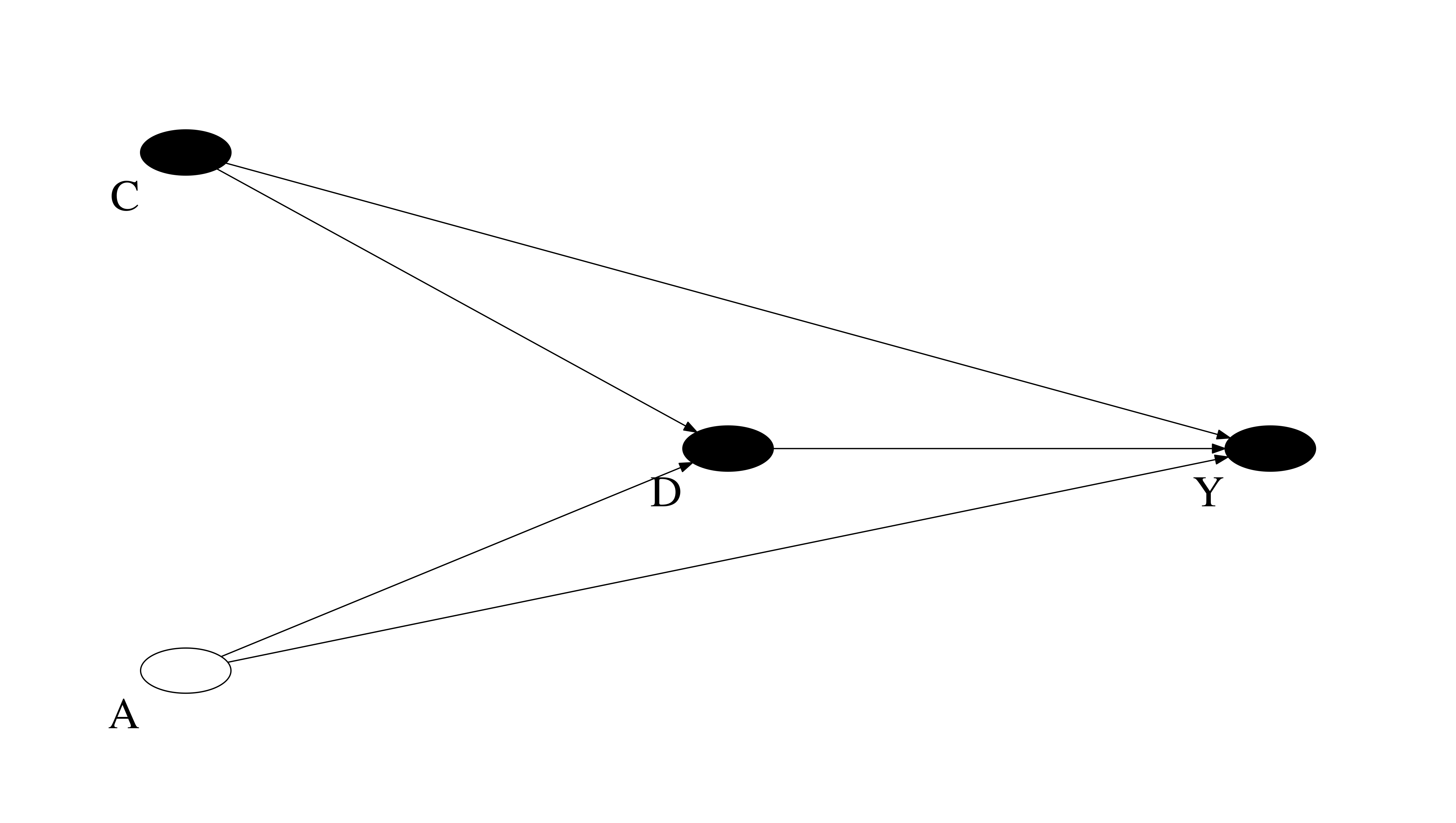
What identification strategies come to mind?
Link to structural equations
Let’s look at another example and assume we are interested in the effect of parental background (P), charter schools (D), and neighborhoods (N) on test scores (Y).
We could set up the following linear regression equations:
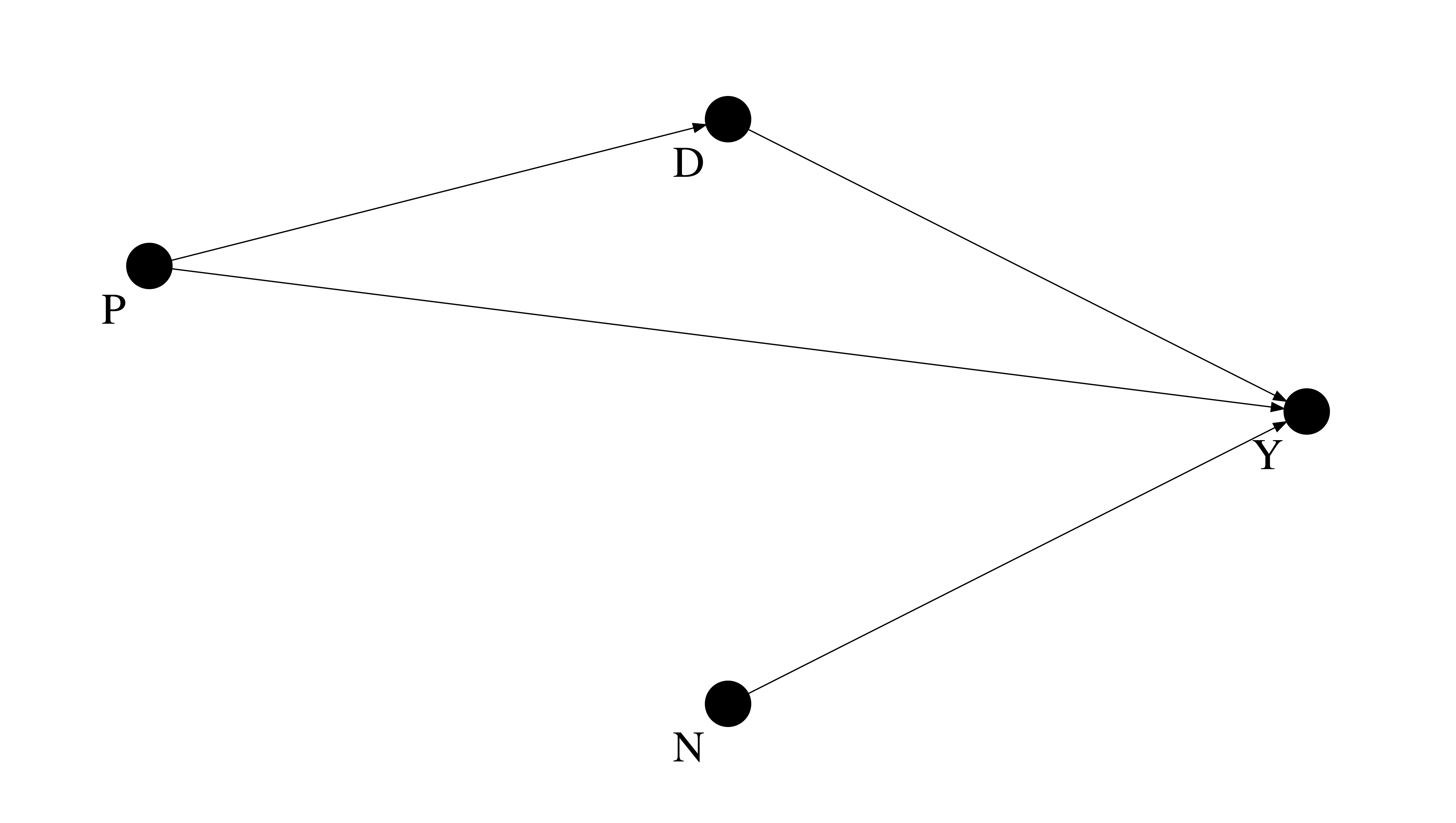
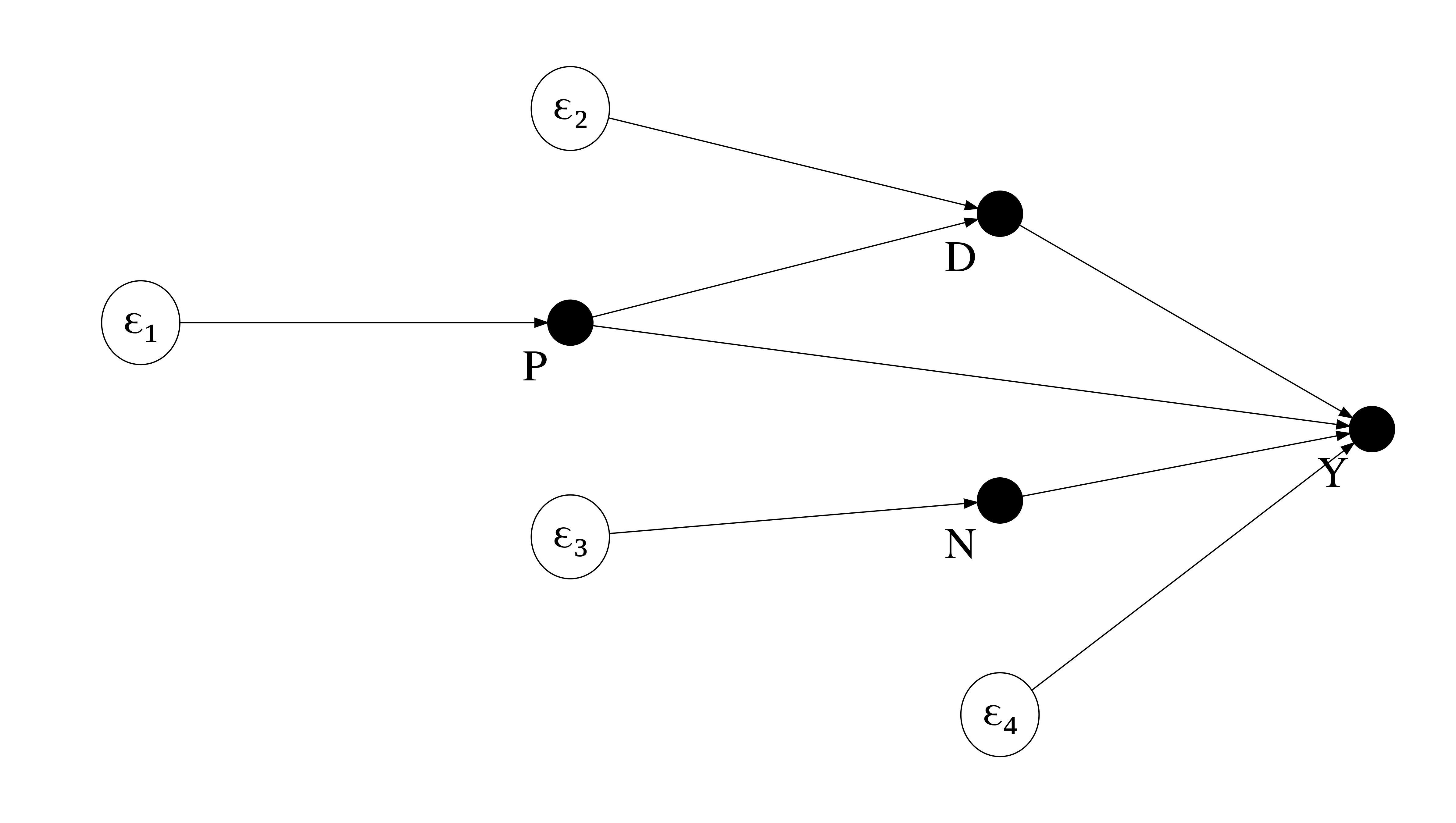
We can set up the same nonparametric structural equations for both representations:
How to simulate a sample from a set of structural equations?
[2]:
indices = list()
[indices.append(label) for label in product([("alpha")], ("D", "Y"))]
[indices.append(label) for label in product([("beta")], ("P", "N", "D"))]
index = pd.MultiIndex.from_tuples(indices, names=["group", "element"])
values = [1, 1, 0.8, 0.7, -0.3]
params = pd.Series(values, index=index)
# distributional assumptions
get_unobservable = np.random.normal
get_observable = np.random.uniform
num_agents = 10000
df = pd.DataFrame(columns=["Y", "D", "P", "N"])
for i in range(num_agents):
P, N = get_observable(size=2)
D = params.loc["alpha", "D"] + params.loc["beta", "P"] * P + get_unobservable()
Y = (
params.loc["alpha", "Y"]
+ params.loc["beta", "D"] * D
+ params.loc["beta", "P"] * P
+ params.loc["beta", "N"] * N
+ get_unobservable()
)
df.loc[i] = [Y, D, P, N]
df.head()
[2]:
| Y | D | P | N | |
|---|---|---|---|---|
| 0 | 1.248681 | 3.289100 | 0.928133 | 0.297718 |
| 1 | 1.791849 | 1.665443 | 0.221006 | 0.472631 |
| 2 | 1.181537 | 0.400000 | 0.366633 | 0.706849 |
| 3 | 1.875180 | 1.226666 | 0.189232 | 0.916127 |
| 4 | 3.442131 | 1.271353 | 0.025105 | 0.976486 |
Now lets see if we can uncover the structural parameters by a simple ordinary-least-squares regression and thus go full circle from a parametric structural equation model to a causal graph.
[3]:
params
[3]:
group element
alpha D 1.0
Y 1.0
beta P 0.8
N 0.7
D -0.3
dtype: float64
[4]:
smf.ols(formula="Y ~ D + P + N", data=df).fit().summary()
[4]:
| Dep. Variable: | Y | R-squared: | 0.143 |
|---|---|---|---|
| Model: | OLS | Adj. R-squared: | 0.143 |
| Method: | Least Squares | F-statistic: | 556.2 |
| Date: | Tue, 04 May 2021 | Prob (F-statistic): | 0.00 |
| Time: | 21:05:08 | Log-Likelihood: | -14101. |
| No. Observations: | 10000 | AIC: | 2.821e+04 |
| Df Residuals: | 9996 | BIC: | 2.824e+04 |
| Df Model: | 3 | ||
| Covariance Type: | nonrobust |
| coef | std err | t | P>|t| | [0.025 | 0.975] | |
|---|---|---|---|---|---|---|
| Intercept | 0.9686 | 0.028 | 34.853 | 0.000 | 0.914 | 1.023 |
| D | -0.2997 | 0.010 | -30.384 | 0.000 | -0.319 | -0.280 |
| P | 0.8276 | 0.035 | 23.439 | 0.000 | 0.758 | 0.897 |
| N | 0.7401 | 0.034 | 21.574 | 0.000 | 0.673 | 0.807 |
| Omnibus: | 2.466 | Durbin-Watson: | 1.998 |
|---|---|---|---|
| Prob(Omnibus): | 0.291 | Jarque-Bera (JB): | 2.400 |
| Skew: | -0.010 | Prob(JB): | 0.301 |
| Kurtosis: | 2.927 | Cond. No. | 8.68 |
Notes:
[1] Standard Errors assume that the covariance matrix of the errors is correctly specified.
Link to potential outcome model
Advantages of the potential outcome model
definition of causal effects
individual effects as first principle
decomposition of sources of inconsistency
…
However, it is hard to manage the notion for larger causal systems with many confounding variables and treatments.
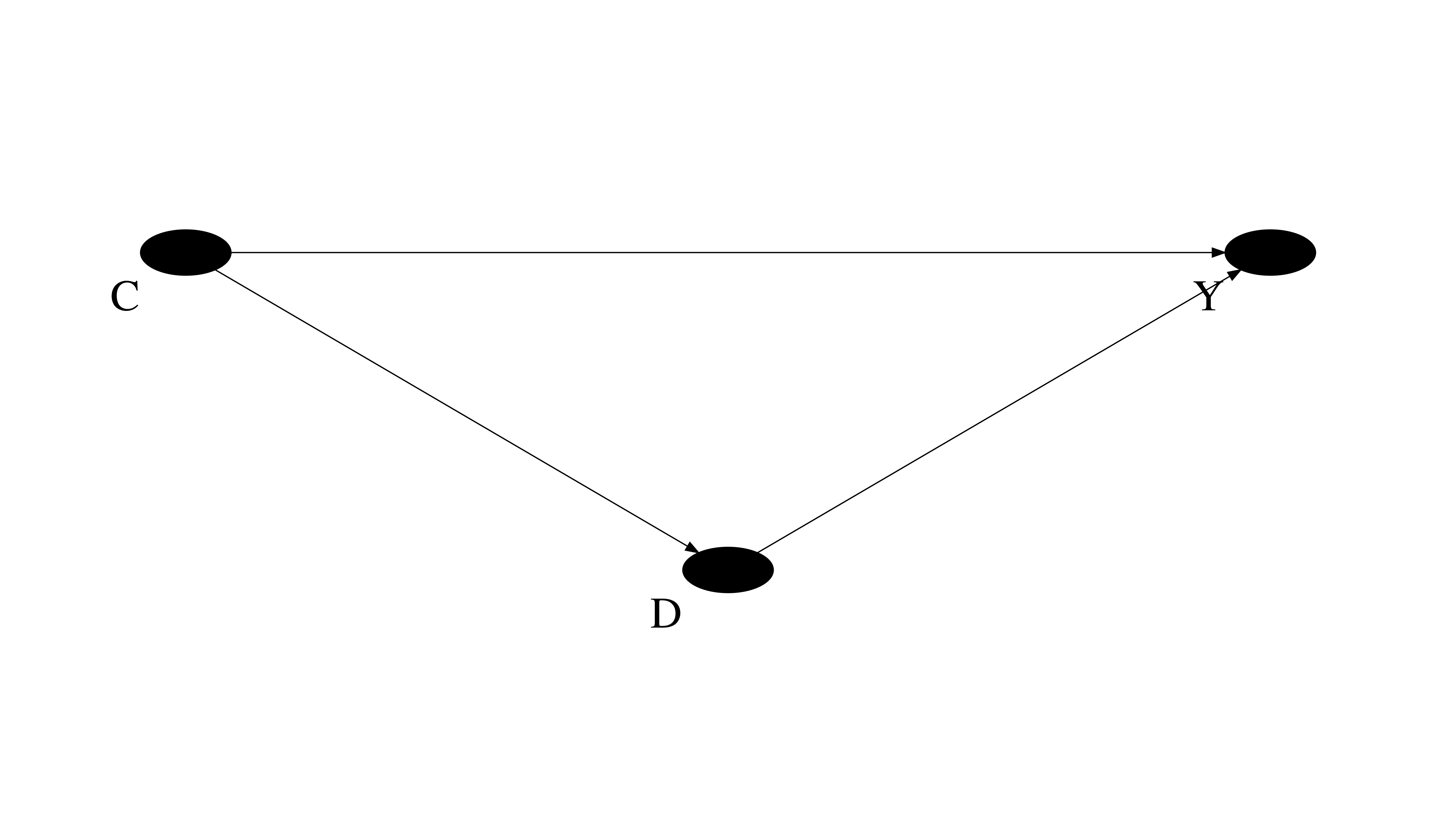
Based on our previous discussion, unfortunately, \(E[Y_1 - Y_0] \neq E[Y\mid D = 1] - E[Y\mid D = 0]\).
How can we define the treatment effects from the potential outcome model in here?
Interventions and counterfactuals are defined through a mathematical operator called \(do(\cdot)\), which simulates physical interventions by deleting certain functions from the model, replacing them with a constant. (Pearl, 2012)
The \(do(\cdot)\) operator is the exact analog to the superscripts given to potential outcomes in order to designate the underlying causal states that define them.
Graphical presentation of \(do(\cdot)\) operator
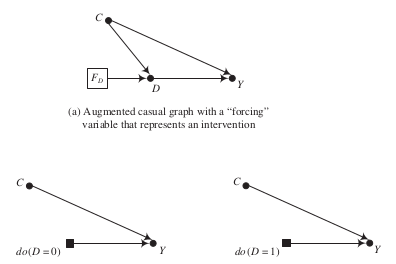
The \(do(\cdot)\) operator induces a key distinction between the conditional distribution of the endogenous variable and its interventional distribution.
Let’s simulate a sample from a parametrized version of the graph above.
[5]:
np.random.seed(123)
num_agents = 1000
df = pd.DataFrame(columns=["Y", "D", "C"])
def calculate_outcome(C, D):
"""We compute the observed outcome."""
# If you would like to have it in potential
# outcome notation.
Y_1 = 1 + C
Y_0 = 0 + C
Y = D * Y_1 + (1 - D) * Y_0
# So what is the individual treatment effect?:
return Y
for i in range(num_agents):
C = np.random.uniform()
D = np.random.choice([0, 1], p=[C, 1 - C])
Y = calculate_outcome(C, D)
df.loc[i] = [Y, D, C]
df.head()
[5]:
| Y | D | C | |
|---|---|---|---|
| 0 | 1.696469 | 0.0 | 0.696469 |
| 1 | 1.226851 | 1.0 | 0.226851 |
| 2 | 1.719469 | 0.0 | 0.719469 |
| 3 | 1.980764 | 0.0 | 0.980764 |
| 4 | 1.480932 | 0.0 | 0.480932 |
We know how to compute and plot a conditional distribution.
[6]:
plot_conditional_distribution(df)
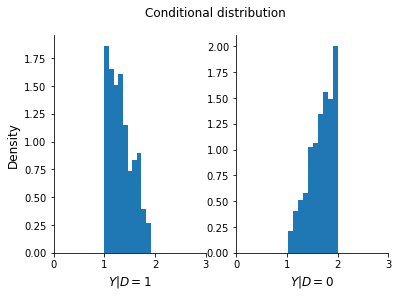
How can we compute the interventional distribution? What do we need to know to do that?
[7]:
Y_do_1, Y_do_0 = list(), list()
for i, row in df.iterrows():
# Note that we calculate the outcome using the
# individual"s actual C put simply set D to
# its value unter the intervetion.
C, D = row["C"], 1
Y_do_1 += [calculate_outcome(C, D)]
C, D = row["C"], 0
Y_do_0 += [calculate_outcome(C, D)]
plot_interventional_distribution(Y_do_1, Y_do_0)
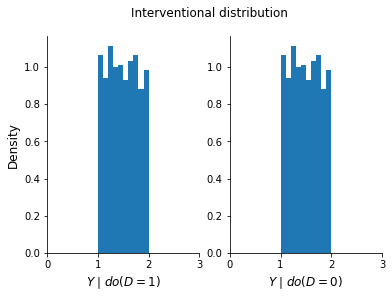
Resources
Manski, C. F. (1995). Identification problems in the social sciences. Cambridge, UK: Harvard University Press.
Pearl, J. (2012). The do-calculus revisited.
Peters, J., Janzig, D., and Schölkopf, B. (2018). Elements of causal inference: Foundations and learning algorithms. Cambridge, MA: The MIT Press.
Imbens, G. W. (2020). Potential outcome and directed acyclic graph approaches to causality: Relevance for empirical practice in economics. Journal of Economic Literature, 58(4).
Hünermund, P. and Bareinboim, E. (2019). Causal inference and data-fusion in econometrics. arXiv preprint arXiv:1912.09104.
Pearl, J. (2009). Causal inference in statistics: An overview. Statistics Surveys, 3, 96-146.